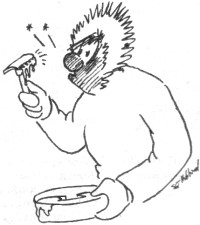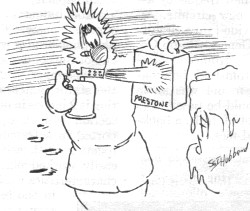April 1945 QST
 Table
of Contents Table
of Contents
Wax nostalgic about and learn from the history of early electronics. See articles
from
QST, published December 1915 - present (visit ARRL
for info). All copyrights hereby acknowledged.
|
Even though my fingers stop working when
exposed to temperatures below freezing, I love the northern climate - four full
seasons, snow, iced-over lakes, migrating birds, fiery autumns, cool summers,
the whole experience. Having the option of not participating in the cold outdoor
environs is what makes it good. However, the U.S. Army Signal Corps guys pulling
duty in Alaska during World War II did not have that luxury. As told by
radio engineer Major Colvin in this story from a 1945 edition of ARRL's QST
magazine, winter life in Alaska at -40° was a real challenge. It was a world
where Prestone antifreeze froze, the sun shone only a few hours a day, vehicles
had to be left running 24/7 or risk not being able to be re-started, and mile-long
treks between buildings was common. There were no snowmobiles. The success of
the communications station was attributed to "the high percentage of amateur
radio operators and technicians."
Establishing Signal Corps Radio Stations at 72 Degrees
Below Zero

Official U.S. Army Signal Corps Photographs
By Major Lloyd D. Colvin* SC, K7KG
One question always asked of troops returning from the Alaska Highway is
this: "How cold is it up there?" Prior to my assignment in October, 1942, as
a radio engineer on the Alaska Highway I had spent nearly two years in various
parts of Alaska. I thought I knew what cold was - but I had a surprise coming.
During the winter of 1942 the weather along the route followed by the Highway
has been officially described as perhaps the coldest ever experienced in that
area. At the time of my arrival at Army Highway Headquarters, located in Whitehorse,
Yukon Territory, the temperature was 25° below zero. That first night I slept
with two other officers in a tent near the airfield. In the morning, after considerable
hunting, we found enough wood to build a fire in a small stove near the center
of the tent and heated some water. When the water was boiling I took some in
a pan to the entrance of the tent, where I could see better, and started to
shave. Before I had finished shaving, ice had formed all around the edge of
the pan!
 My first job was supervision of the building
and operation of a large high-speed radio station at Whitehorse to serve the
Army Headquarters. The installation consisted of a multiposition operating room
near the headquarters establishment, with remote receiving and transmitting
stations. My first job was supervision of the building
and operation of a large high-speed radio station at Whitehorse to serve the
Army Headquarters. The installation consisted of a multiposition operating room
near the headquarters establishment, with remote receiving and transmitting
stations.
The Army troops and contractors had moved into Whitehorse faster than supplies
could follow them. There seemed to be a scarcity of everything except cold weather.
Transportation - or the lack of it - was the biggest problem, however. I had
been instructed to get the station on the air at the earliest possible date,
but work on signal facilities was at a standstill because of the lack of transportation.
The distance from the operating room to the receiving station was three miles,
while the distance from the operating room to the transmitting station was six
miles. Neither the buildings nor the antennas at either site had been completed.
With the extreme cold that prevailed it was imperative that some kind of a vehicle
be obtained to get the Signal Corps personnel to and from work.
In my search for transportation I saw everyone from second lieutenants to
the commanding general. All were very sorry, but all available Army transportation
that would run was needed to haul food and clothing to keep the men alive.
In desperation I started a canvass of the stores in the village of Whitehorse,
asking, "Does anyone know of a civilian who has a car or truck that could be
rented or bought?" The village fire chief was finally located. His job as fire
chief was only a part-time duty, but he had an old Ford pick-up, painted red,
which he used to take him to what had previously been the very infrequent local
fires. After considerable persuasion I talked him into renting this vehicle
to me. I had no authority to make such a contract, but the Army eventually paid
the bill.

A large high-speed Station at Whitehorse
With the aid of our new "fire wagon," work was resumed. The vehicle was too
small to take all the men to either the receiver or the transmitter sites in
one load, but by making shuttle trips we managed to get everyone to and from
work. In spite of the cold the radio station was completed and on the air in
a few weeks.
Eventually we received several Army vehicles for Signal Corps use. However,
our troubles were not over. These cars and trucks originally belonged to the
first engineer troops who worked on the highway. The vehicles had already taken
a terrific beating before they were turned over to the Signal Corps, and only
one of them would run.
All repair work had to be done out in the open because no garage could be
found for the vehicles and no material was available with which to build one.
The temperature was 50° below zero when we started to repair the trucks. After
several days of such work, I started out one morning to see how the work was
progressing. The temperature was only about 20° below and I had on several coats,
a parka, shoepacs with two pairs of heavy woolen socks, and two pairs of gloves
- but I still felt cold. When I reached the vehicles I found one of the Signal
Corps mechanics wearing about half the amount of clothing I had on, with no
gloves, handling metal parts with his bare hands. He was whistling and appeared
to be in the best of spirits. Turning to me, he said, "Good morning, sir. Much
warmer this morning, isn't it, sir?"
 On another occasion, after we had one vehicle
repaired and were in high hopes it would run, we discovered we had no antifreeze
for the radiator. Not having a car available that would run, I walked a mile
to a quartermasters' warehouse where I could draw Prestone. It was one of our
coldest days. After two trips I got enough anti-freeze to fill the repaired
car - but when I finally got the cans open, the pure Prestone was frozen solid!
I was mad enough to fight the whole war alone. On another occasion, after we had one vehicle
repaired and were in high hopes it would run, we discovered we had no antifreeze
for the radiator. Not having a car available that would run, I walked a mile
to a quartermasters' warehouse where I could draw Prestone. It was one of our
coldest days. After two trips I got enough anti-freeze to fill the repaired
car - but when I finally got the cans open, the pure Prestone was frozen solid!
I was mad enough to fight the whole war alone.
We found that the oil would freeze in the cars unless we let them run all
night. The latter plan was reasonably satisfactory except when a drop of water
got into the gas line. When this happened the engine would stop and everything
would freeze up.
During most of that first winter some supplies had to be flown in by airplane.
The Air Corps had very little covered storage space, and as a result many tons
of the equipment and supplies unloaded from planes were left in the snow near
the edge of the airfield.
Much of Christmas Day of 1942 was spent on the airfield in the hope that
the incoming planes would bring Christmas-packages for the men in the radio
section. Just as I was about to leave the field I accidentally kicked the snow
off a box half buried in a drift. Imagine my surprise when I saw my name on
the box! Except for that lucky kick, the box might have remained there until
spring.

Transportation was the biggest problem.
Hoping it would turn out to be a Christmas present, we rushed the box to
the radio station and hurriedly opened it. Imagine my mixed feelings of disappointment
and joy when it turned out to be a much-needed communications receiver for the
station. One of the men lifted the receiver out of the box, placed it on a table
- and then gave a terrific yell. The metal chassis was so cold that when he
let go pieces of flesh were pulled off his hands! After warming up the receiver,
first over a. fire and then in the conventional manner, it was found in perfect
operating order.
Yes, the weather was cold during the building of the Alaska Highway. But,
as in so many other parts of the world, the U. S. Army Signal Corps, with its
high percentage of amateur radio operators and technicians, is providing communications
there of which we can all be proud.
Posted February 24, 2021
(updated from original post on 11/20/2012)
|








 My first job was supervision of the building
and operation of a large high-speed radio station at Whitehorse to serve the
Army Headquarters. The installation consisted of a multiposition operating room
near the headquarters establishment, with remote receiving and transmitting
stations.
My first job was supervision of the building
and operation of a large high-speed radio station at Whitehorse to serve the
Army Headquarters. The installation consisted of a multiposition operating room
near the headquarters establishment, with remote receiving and transmitting
stations. 
 On another occasion, after we had one vehicle
repaired and were in high hopes it would run, we discovered we had no antifreeze
for the radiator. Not having a car available that would run, I walked a mile
to a quartermasters' warehouse where I could draw Prestone. It was one of our
coldest days. After two trips I got enough anti-freeze to fill the repaired
car - but when I finally got the cans open, the pure Prestone was frozen solid!
I was mad enough to fight the whole war alone.
On another occasion, after we had one vehicle
repaired and were in high hopes it would run, we discovered we had no antifreeze
for the radiator. Not having a car available that would run, I walked a mile
to a quartermasters' warehouse where I could draw Prestone. It was one of our
coldest days. After two trips I got enough anti-freeze to fill the repaired
car - but when I finally got the cans open, the pure Prestone was frozen solid!
I was mad enough to fight the whole war alone. 
